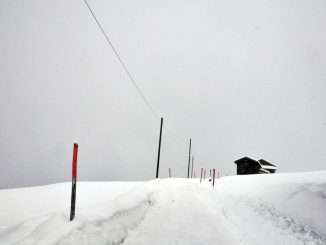
40+ TIPS FOR GATHERING AND SHARING INFORMATION
Editor’s Note: This is one of three sections about communications we published on our Fall/Winter 2018 Prepper Manual. The other two sections are Comms Check! and Let’s Talk Tech.
Before information can be conveyed, it must first be collected through observation or received from other sources. A fundamental aspect of your communications plan is the ability to gather, analyze and pass on factual information. In a dynamic situation, such as a wildfire or social upheaval, stale information might be counter to the current scene. A constant input of fresh intelligence is needed and must be disseminated accurately.
1.0 COLLECTING INFORMATION
1.1 Gathering Information
Direct observation might be the best (or worst) means of getting information.
1.1.1 Something could happen spontaneously before your eyes and be known only by you until you spread the word.
1.1.2 Be aware that things might not be as they appear. Resist speculation and pass on only the facts.
1.1.3 A series of subsequent events could be triggered by one incident; continue to monitor a crisis, even if you believe conditions have returned to normal.
1.2 Consider the Sources
Indirect or outside sources provide critical information and early warnings.
1.2.1 National and local news coverage is our traditional method of reporting events; broadcast television is the most common source of news and weather forecasts.
1.2.2 Internet resources can provide breaking news coverage, additional details and updates to stories.
1.2.3 Emergency notifications might be sent directly to your phone through a reverse-911 service in a growing number of areas of the country. Additionally, you can sign up for alerts to be sent to your cellular or smart phone.
2.0 VALIDATE INFORMATION
2.1 Go Beyond Conventional Sources
2.1.1 Whenever possible, verify information through multiple sources.
2.1.1.1 Media reports are often “canned,” and reporters repeat what they have been given, factual or not.
2.1.1.2 Search for details or differing information from sources local to the event.
2.2 Weather Is Always a Factor
2.2.1 The National Oceanic and Atmospheric Administration (NOAA) and its different divisions, including the National Weather Service (NWS), National Hurricane Center (NHC) and Storm Prediction Center (SPC), provide an immense amount of information from current conditions to weather predictions several days in advance, all of which is available at www.NOAA.gov.
2.2.1.1 Weather radar images are presented as a mosaic that shows storm systems across the entire United States or regionally for more clarity. Radar data is available 24/7 at www.Weather.gov/Radar; or download the MyRadar app to your smart phone.
2.2.1.2 Hurricane information, including predictions, is available from www.NHC.NOAA.gov.
2.2.1.3 Severe weather predictions are extremely valuable, because they show the probability or potential for storm development hours or days before a weather system moves into an area. Along with severe weather, other advisories (such as fire, flooding and excessive heat conditions) can be found at www.SPC.NOAA.gov.
2.2.2 NWS offices are spread throughout the nation. Besides being the primary responsible entity that issues severe weather alerts, weather spotter training is offered in a classroom setting in most areas and is available online. More information on training can be found at www.Skywarn.org.
3.0 YOUR INFORMATION CENTER
3.1 Ideally, all of this information should flow into one area—a nerve center of sorts. This area can be as elaborate or simple as you see fit.
3.1.1 What You’ll Need
At the very least, there should be room and power available for the following:
3.1.2 A television connected to an over-the-air (OTA) broadcast antenna for reception of local stations does not rely solely on cable or satellite television.
3.1.3 A minimum of one computer. Internet access is an absolute must, and I recommend having a printer too. If your Internet service is through a cable or wired phone (DSL) connection, consider adding a wireless Internet/data plan through your cellular phone provider. Many smart phones can be used as an Internet connection for an external device with tethering or mobile hotspot functions, but this will tie up your cell phone.
3.1.4 A portable AM/FM radio (battery powered, with batteries) to tune in broadcast stations for news and weather information. AM radio can also be used as a very effective lightning detector: Simply tune to a very weak station that you can barely hear. If there is lightning in the area, you will hear a brief, but distinctive, scratchy noise from the radio speaker long before you can hear thunder.
3.1.5 A NOAA Weather Alert radio with SAME (Specific Area Message Encoding) programming that allows you to get alerts for specific areas that are important to you.
3.1.6 A desk or table that allows you to arrange items and provides space to take notes. Writing all information in a log-type fashion will help you keep the important details straight. A battery-powered wall or tabletop clock is recommended so you can time-stamp your notes as you put them on paper.
3.1.7 Additional/optional items would include a chalkboard or dry-erase panel, along with a map table with topographic and/or road maps for your area of operation or area of interest.
3.2 A backup power source is critical in the event of a power outage so your nerve center will be able to keep going. This can be a portable generator (located safely outdoors), a battery backup device in the form of an uninterruptable power supply (UPS), a DC-to-AC power inverter connected to a battery bank charged by solar/wind energy or any combination of these.
4.0 RADIO COMMUNICATIONS
4.1 Monitoring a two-way radio can provide insights into local activity or events.
4.1.1 Programmable scanners allow you to listen in on public safety frequencies, as well as FRS, GMRS and amateur radio activity.

Be sure all members of your family or group are capable of operating all comms equipment. An emergency is not the time to try to learn how to call for help!
4.1.2 Software Defined Radio (SDR) devices turn your computer into an extremely capable radio receiver.
4.2 Two-way radio is one of the best methods to keep in touch with family and group members, near or far.

Handheld transceivers are ideal for comms on foot
4.2.1 A two-way radio augments cell phone communications and provides a contingency plan if/when cellular systems fail.
4.2.2 Non-licensed radio services, such as the Family Radio Service (FRS) or Citizens Band (CB), are normally only good for short-range communications.
4.2.3 Licensed services, including General Mobile Radio Service (GMRS) and amateur radio (HAM), cover greater distances and are much more effective and reliable.
5.0 GOING MOBILE
5.1 Conditions could force you to leave your location. With proper planning and gear selection, it’s possible to maintain communications on the go or quickly reestablish them once you get to a safe locale.

If you’re concerned about being able to make your way back to camp in an unfamiliar area or you want others to be able to find you, leaving trail markers is an effective, low-cost and low-tech way of ensuring you’ll be able to find your way.

In some cases, it might be advantageous to use a loud whistle or a signal mirror to summon help … or, they could be your only hope for rescue.
5.1.1 Install mobile radios in all family or group vehicles.
5.1.2 If permanent installation is not possible, equip each vehicle with a handheld transceiver that is connected to an external antenna and pre-programmed for the frequencies that will be used.
5.1.3 Laptop computers or other mobile devices will permit access to Internet resources.
5.2 Provide those who might be away from home when disaster strikes with communications capabilities besides their cell phone.

This battery bank and solar charge controller are important aspects of the author’s comms center plan
5.2.1 A pre-programmed handheld transceiver, along with extra batteries, should be carried in their vehicle or backpack.
5.2.2 Train all family and group members on the operation of any gear they don’t use on a regular basis, and be sure to include concise written instructions for reference.
5.3 In a bug-out scenario, some personnel might be unreachable.

Charge mobile devices with portable solar panels and a battery power pack. This setup can quickly be stowed and transported for use away from home if the author (or you) needs to bug out.
5.3.1 Leave written instructions behind—but keep security in mind by using a confidential location and coded language that anyone outside your group will not understand.
5.3.2 Develop and distribute contingency plans with procedures, meet-up locations and other details necessary to improve the odds of survival.
6.0 PLAN B
6.1 Equip and train all members with the tools and skills necessary for non-electronic communications.
Editor’s note: A version of this article first appeared in the Prepper Fall, 2018 print issue of American Survival Guide.






Be the first to comment